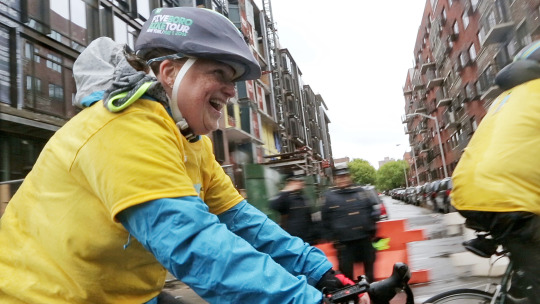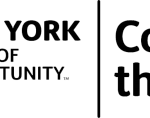Conversations | Director Carolyn Jones on “Defining Hope”
“If we focus on the fact that we have a limited amount of time here, could we make better choices? Could we cherish one another more?” – Carolyn Jones, Fiscally Sponsored filmmaker
Carolyn Jones is a filmmaker and photographer who gracefully documents intimate stories highlighting the power of courage and human dignity. Utilizing the transformative elements of storytelling, Jones’s projects, from Living Proof: Courage in the Face of AIDS (1994) and The American Nurse (2012), are spirited and powerful, creating both a realism and an optimism that allows us to confront the true nature of the things we perhaps forget about the most.
Jones’s most recent film, Defining Hope (2017) is a documentary that weaves together stories of patients who are confronted with life-threatening illnesses. The film entrusts audiences with that same effect. When we spoke with her recently, Jones stated, “I had discovered early on that life is somehow brighter when death is in the room.” The film situates us in that room and makes us question, What makes life worth living? What are our choices?
Read through the interview with Jones here to learn more about her own considerations on death and the choices we make in life, and how NYFA Fiscal Sponsorship, as well as various partnerships with healthcare entities, helped make Defining Hope (Sponsored Project) a reality. You can see the film in various locations throughout the U.S.
Defining Hope Screening Information
When: October 21, 2017 at 5:00 PM
Where: Carmel International Film Festival, Carmel, CA
Tickets: Purchase here.
When: November 1, 2017
Where: In select U.S. theaters; find a screening near you.
NYFA: As an award-winning photographer and filmmaker with a professional history in commercial projects, what drew you to begin capturing personal stories that illuminate the human condition?
Carolyn Jones: I authored a book called Living Proof: Courage in the Face of AIDS in 1994, and it changed the course of my career. I spent a year photographing and interviewing people who were living positively with AIDS. I spoke to them about what mattered most in their lives, whom they loved, and what gave them purpose. Those meaningful conversations made me think about my own life in a new way. I realized the power of storytelling and how transformative it can be.
NYFA: Which experiences, circumstances, or lessons led you to undertake a documentary project that sheds light on the choices one has to make under life threatening circumstances?
CJ: Ever since I worked on Living Proof and spent so much time with people at the end of life—in 1994, the drugs available for treating AIDS were far more limited—I have been interested in how much we can learn about life and what’s important when we are at the end of life. I had discovered early on that life is somehow brighter when death is in the room. I have often wondered if there was a way to feel that appreciation of life, that sense of cherishing simple things, and bring that forward into our everyday existence. When we see how fragile life really is, we cherish it. If we focus on the fact that we have a limited amount of time here, could we make better choices? Could we cherish one another more?
As soon as I started working on The American Nurse Project, I became focused on how complicated our end of life experience has become with the development of new technologies. We have to make difficult choices, and I believe that if we can witness others and hear their stories when they are at these complicated junctures, we can learn and make better choices when we, or our loved ones, are faced with the same challenges.

NYFA: Much of the content of Defining Hope is personal for your subjects. Were there any difficult, ethical dilemmas you faced when filming and interviewing?
CJ: Yes, there was one. When I started this project, I believed that we have a responsibility as citizens to know when to stop fighting, to accept the inevitable, and face our fate with some grace. I believed that we had to learn to not tax the system by going far beyond what is natural to prolong our life and avoid the dying process. I truly believed that this is our responsibility, and I wanted to make a film that guided people toward that end. I also believed that as patients we had to learn to make better choices, so that we don’t spend our last days in intensive care units, unconscious with tubes coming out of every orifice when in fact we could be, if possible, surrounded by family in a completely different setting that hospice could help us find.
There is a young woman named Alena in Defining Hope who was presented with the choice of brain surgery to remove a recurring brain tumor located dangerously close to the part of her brain that holds her short term memory. I was in the room when the surgery was suggested. Every bone in my body told me to pipe in with “Don’t do it! Don’t take the chance. Travel and see the world and write about your experiences—don’t risk losing everything.” But of course being a documentary filmmaker is like being an anthropologist; you’re there to observe and record, not change the course of someone’s life. So I stayed quiet, and I had to really watch and listen what was going on in that room as Alena and her parents decided to move forward with the surgery. I realized right then and there, that there is no right or wrong. The will to live is powerful, and we each have to make our choices when we are ready in our own way. On that day, the name of my film was changed from Dying in America to Defining Hope.
NYFA: The film shares just a handful of stories, but countless interviews were conducted for research. Can you tell us a story about an individual who stood out to you but whose story did not, in the end, fit within the narrative’s arc?
CJ: We met a young family who had been faced with incredibly difficult choices. They were informed, before their baby was born, that she would most likely not live out the week. This young family was told that their precious child’s health was “not compatible with life.” They brought their child into the world and she was immediately placed on hospice care. They knew that the best case scenario, with the genetic issues that she has, would be that she would live for four years. The progression of this child’s illness and symptom management was like putting a finger in a hole in a dam, one finger at a time. Each time one issue was solved, another came forward. This child had to undergo so many treatments and surgeries, and this young family had to be so strong. It brought up many questions. I didn’t think I could do justice to the story in the time frame that we had, so I didn’t include it in the end, but it continues to haunt me.

NYFA: How do you envision this film being used? Who is the target audience, and what would you like them to consider?
CJ: My dream is that this film is a tool used by people in the healthcare field to look at patients through a different lens, and also by the public who can hear the words of family members in the film as they let their loved ones go, or support their wishes.
We need to let our loved ones know what we want. Technology has made decisions infinitely more difficult than they ever were before, and new life-saving technologies will make decisions even more complicated. Someone needs to know what we want and advocate for us. Almost all of us will have decisions to make or be made for us—the best thing we can do is let someone know what makes life worth living to us personally. So I hope people will see the film and look to someone they love and say, “When it’s me, I hope you can let me die the way Bert did,” or “I hope you’ll help me keep fighting.”
NYFA: Which organizations have partnered with the film and what criteria do you take into account when deciding to partner with them? What roles do these organizations play in outreach?
CJ: It was really important that we partnered with organizations that philosophically are aligned with us. The Jonas Center for Nursing and Veterans Healthcare and the The American Nurses Foundation were obvious choices since I believe nurses are in a profoundly unique position to guide us at the end of life. I am committed to doing whatever I can to encourage people to reach out to nurses for guidance. I have always wanted the footage gathered for the film to be used as a learning tool for healthcare professionals. There are so many teaching moments in the film, so we were excited to bring Walden University into our group of partners. We wanted an educational partner who would offer CNE credits to nursing professionals for watching the film. All of these organizations will help enormously with our outreach.
NYFA: What first led you to initially seek NYFA Fiscal Sponsorship, and how has it helped in achieving the film’s goals?
CJ: Many years ago when I was working on Living Proof, I chose NYFA as my Fiscal Sponsor. I found guidance and advice then that was invaluable. I hoped to find that same level of thoughtfulness and guidance again with this project and I wasn’t disappointed. When we have reached out with questions we have received such well thought-out responses, and I’m grateful for that.
Carolyn Jones is an award-winning photographer and filmmaker who specializes in telling stories that shed light on issues of global concern. From people “living positively” with AIDS to women artisans supporting entire communities and nurses on the frontlines of our healthcare system, Carolyn Jones has devoted her career to celebrating invisible populations and breaking down barriers. Her most widely acclaimed book publications include Living Proof: Courage in the Face of AIDS and The American Nurse, which led to a feature documentary included in the U.S. State Department’s American Film Showcase. Jones’ career was punctuated by two brushes with death: first, running out of gas in the Sahara as a racecar driver, and second, a breast cancer diagnosis. Her newest project, the forthcoming documentary Defining Hope, is the culmination of a journey investigating how we can make better end-of-life choices.
– Interview conducted by Priscilla Son, Program Assistant, Fiscal Sponsorship & Finance
Are you an artist or new organization interested in expanding your fundraising capacity through NYFA Fiscal Sponsorship? We accept applications on a quarterly basis and our next no-fee deadline is December 31. Click here to learn more about the program, current fiscally-sponsored projects, and to apply.
Images: Film stills by Jaka Vinšek, cinematographer of Defining Hope (Sponsored Project)





